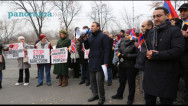
Aris Ghazinyan: Over 350,000 Armenians from different regions deported into Persia on Abbas I’s order
There is a hill in Yerevan the Turkic people call Mountain of Disasters (“Mukhannet tepesi” or “Mukhannat tapa”). The Armenians have called the place Hill of Civilisation from time immemorial. This had a reason – the civilisation has flourished here since the ancient times and the settlement has always been engaged in an active life. After four thousand years, Abbas I set up a camp in this very territory. Armenian journalist and researcher Aris Ghazinyan writes about it in his book “Yerevan: with a cross or on the cross,” which is an attempt of setting and considering an extremely diverse range of processes directly or indirectly forming the character of the development of the territory in question and predetermining the inevitability of turning Yerevan into the main centre of the Eastern Armenia, and later on into the capital of the recovered Armenian state.
The shah was met in Yerevan by about three thousand cutthroats from Qizilbash tribes Tulengi and Gek-Tolak, people of naib Alaeddin Bey (who was named the ruler of Nakhijevan and Kapan for taking part in the conquest of those “mahals” on Abbas’ side) and Mustafa Bey (the naib of Maku), as well as Kurdish gangs with their atamans Zeynel Bey, Kuchi Bey, Kurt Gazi, Seifeddin Kurk, Mirpashaoglu Shaykh Haydar, Kilic Bey.
The siege of Yerevan Fortress began on 17 November 1603. He first battle took place in the same evening; Yerevan Fortress, however, endured. Gezji Kala, a fortress on the right bank of the river Hrazdan, also defended itself successfully. The battle continued on the next day but the Sunnis could again retain their positions. At the end of the first week, the shah himself rose the flags and went assaulting the bastion. Although the Sunnis withdrew into the fortress, they made it clear to him that the garrison was not going to surrender easily.
Yerevan’s siege went on for nine months. The assaults that were coming almost every day (especially at the beginning of the campaign) could not throw the Ottoman banners off the tower flagpoles, something the Qizilbash army was longing for. In the end, a decision was made to take the fortress with attrition. The “civilians” (the Armenians), that had been driven into the fortress, had no other choice but share the hardships of the siege with the Ottomans. Meanwhile, some Armenians were fighting against the Turks on Shah Abbas’ side (particularly, his commander Allahverdi Khan). According to Ghazinyan, the Ottoman sources create a false impression that the Armenians allegedly were supporting the sieged garrison.
For example, this sources claim that, when all the water reserves ran out in the fortress on the 12th day of the siege, a decision was made to dig a tunnel to the riverbed of the Hrazdan “for the sake of the needs of the inhabitants of the city.” By “inhabitants of the city,” the chroniclers implied Yerevan’s Armenians and, completely in tune with the Ottoman historiography, presented the defence of the fortress as “an act of humanity.” “Although the Ottoman author uses phrases like ‘the Ottomans and Armenians,’ ‘common decision,’ ‘needs of the inhabitants of the city,’ and others, the relations inside the fortress were not so smooth,” Ghazinyan points out. He notes a number of records about cases of unrests and escapes.
Situated “on the crossroads of times and spaces, roads and ambitions,” Yerevan was not only boiling in the cauldron of the collisions between the Ottomans and Qizilbashes, but had also been deprived of its indigenous administrator by 1604. Even retrospectively ¬– right in the context of Armenian perspectives – it is impossible today to fully embrace and realise the whole scale of the consequences of the policy of Abbas I. “The impact was universal. Suffice it to mention the complete depopulation of the Ararat Plain, the mass deportation of the indigenous population and its replacement of other-language tribes as a result of the shah’s peculiar attitude about the issue of the necessity of using the Armenian resource,” the author writes.
The mass deportation of Yerevan’s population far inland of the Persian country went hand in hand with the siege of the fortress, and acquired unimaginable scales after its capitulation. The shah had conceived this plan well before capturing the fortress. Therefore, during the Yerevan siege, he already sent troops to the western Armenian lands, where the population was long since languishing under the unbearable pressure of the Ottoman burden. A war was on, and if the centre of the battles moved to Yerevan for a while, the theatre of the military operations itself took up rather a wide territory, Ghazinyan writes.
Arakel Davrizhetsi, an Armenian chronicler who witnessed the events, writes the following, “While fighting and sieging Yerevan fortress, the shah was restlessly destroying the country and driving the Armenians into captivity. He sent his military commanders with a great number of troops towards Erzerum. They set on their way, ravaged Basen and Khnus regions, Erzerum valley and other lands <…> destroying, ruining, burning and desecrating the regions and settlements, looting the belongings and property, slaughtering men, taking women and children captive and bringing them to their camp in Yerevan.”
According to Ghazinyan, Yerevan was initially marked in Shah Abbas I’s plans as a place of primary re-deployment of the Armenian population with the aim of driving them further inland into Persia later. The Armenians’ mass deportation received the name “The Great Surgun.”
Yerevan Fortress fell in the summer of 1604. In the Ararat side, the dreadful shah found people whose abilities shocked him. They were the only ones that could equip the Persian rear, master the lands, enliven the trade and arrange the crafts. The shah made up his mind to use the Armenian talents for the sake of prosperity of his state.
As a plausible excuse for the deportation, Abbas I used the Erzrum counter-attack of the Ottoman army under Jgal-ogli. Pretending as if sympathising the Armenians, he told the Armenian bashaws and elders that Jgal-ogli was already entering the country of the Armenians with a countless army. “Sympathising you, I want to save you in the following way: let the villagers and the inhabitants of your country rise from their places and move a little and walk a several-days way. Meanwhile, we will stop the Ottomans’ advance and start a battle with them. If God gives us success, you will go back to your places and become our homagers. And if Gods gives them a victory, we will leave and you will return to become their homagers.”
The Armenians, however, attempted to reject the shah’s offer. Particularly, dignitary Ter Hovhannes told the shah that “all the people are not ready to set on a journey, everyone does not have draught or other animals to load the belongings and children on them; although the healthy and the strong will go on foot, the old people and the children cannot walk.”
According to Davrizhetsi, the shah “did not heed the Armenians’ pleas.” Calling the bashaws, he appointed some of them as overseers and ordered each of them to take the population out of one region. Amirgun-khan was assigned to move Yerevan’s residents.
As a result, over 350,000 Armenians were deported into Persia from different regions of the country. “The shah turned the prosperous and fertile Armenia into an inhabitable desert. During the resettlement, he drove the residents to Persia from the borders of Nakhijevan through Yeghegnadzor up to the boundaries of Gegham, Lori and Hamzachiman gavars, Aparan, Sharafkhaneh, Shirakavan, Zarishat and a part of the villages of Kars, the gorge of Kaghzvan, the entire Alashkert region, the villages of Maku, Aghbak region, Salmast, Khoy and Urmia, the entire Ararat Plain, the city Yerevan, Kirkhbulakh land, Tsaghkunts gorge, Garni gorge and Urtsadzor. Before that, the population of the gavars of Karin, Basen, Khnus, Manazkert, Artske, Ardjesh, Berkri and Van had been exiled, being looted and taken captive. The loot and the captives were taken to Yerevan and exiled further with the rest,” Davrizhetsi writes as cited by Ghazinyan.
The first and the most large-scale stage of the Armenian exodus lasted for almost eight months (until the mid-1605, when the city was completely occupied by the Qizilbash army). “Frightening with sword, death and captivity, the shah ordered to drive (the residents) out of everywhere his commanders went, exile them and not to leave a single living soul <…> Receiving the all-destroying and cruel order, each of the commanders marched off with his regiment and set on to the gavar of the Armenian country where he was ordered and told to. As a raging flame would rush along a cane, they drove front the panicked and alarmed inhabitants of the gavars, who were driven out of their homes everywhere. They drove them forcibly, as a huge army of herds, to Yerevan, where they occupied the vast plain from one end to the other. The width of the camp extended from the foot of Garni Mountains to the banks of the big river Eraskh. Measure the length yourself – a day’s way, but I have seen that in some other places it is written a five-day way,” Davrizhetsi writes.
“Hundreds of thousands of hopeless Armenians, hundreds of thousands of broken fates that remelted in a common national fate and went into oblivion in consecutive stages. The Ararat Plain was deprived of its master. The Armenian nation could hardly ever recover its state if Yerevan failed to demonstrate a stupendous immunity and gather the Armenians by fractions yet another time,” Ghazinyan writes.
To be continued
Aris Ghazinyan’s “Yerevan: with a cross or on the cross” is a book about the social and political history of Yerevan and Yerevan district (as a habitat) since the declaration of Christianity to the beginning of XIX century. In addition to demonstrating historical facts based on archive documents and sources, the book also considers the fundamental theses of the Azerbaijani historiography and Pan-Turkic ideology aimed at appropriating the historical, cultural, and spiritual heritage of the Armenians and other nations of the region by falsifying their history.
Related news
- Aris Ghazinyan: Seeing Armenians’ well-ordered lands, Abbas I started working out plans of using Armenian resource in economic development of country
- Aris Ghazinyan: Timur took thousands of Armenians out of Armenia to develop crafts and trade in his empire
- Aris Ghazinyan: Yerevan became place of pilgrimage for Christians since late 13th century
- Aris Ghazinyan: Average seventh-century inhabitant of Yerevan embodied collective image of the Armenian of that time
- Aris Ghazinyan: Territory of Yerevan generates unlimited time in its limited borders
Newsfeed
Videos






























